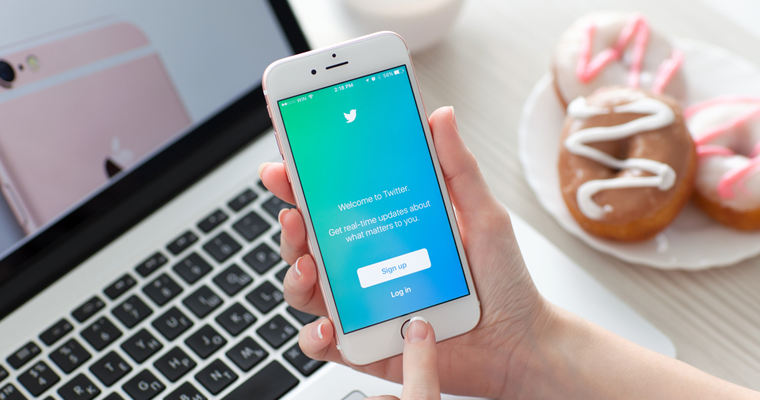With 320 million active monthly users, Twitter made a splashy announcement (as they usually do) back in February when they debuted a non-reverse chronological timeline, not a small or unnoticed change, but a real-time algorithmic change to the beloved Twitter timeline. Jack Dorsey, CEO of Twitter, stated: “Twitter can help make connections in real-time based on dynamic interests and topics, rather than a static social/friend graph.”
Twitter can help make connections in real-time based on dynamic interests and topics, rather than a static social/friend graph. We get it.
— Jack (@jack) February 6, 2016
We all live in a world of real-time and instant gratification when it comes to social media (and just about everything else — thank you, Seamless). But, like peeking into a purse, your Twitter timeline shows what you care about and keeps you up-to-date on the latest trends. But it’s never been static — it always changes.
I think the Twitter timeline change is a good idea for brands and marketers to refresh their Twitter strategies once in a while. It’s a move by Twitter that was inevitable. To compete with brands like WhatsApp, Facebook, and Snapchat, Twitter needs to build out a more brand-friendly platform even if it peeves core users.
So, in addition to insights into how SEJ does Twitter, I’m sharing insider tips into how I’m adjusting my Twitter strategy. These are the tips that I’m using, loving…and maybe a little obsessed with. Some may be old staples, such as Buffer or Promoted Tweets, while others are tricks I learned this week.
How Does the Twitter Timeline Work?
Instead of sorting tweets in the most current material, the new Twitter algorithm will group your “best” tweets for you first based on your previous interactions. It will also consider content you missed “While You Were Away” which I love because it sends me highlights of the day that I may have missed during my daily stalking session.
Twitter’s VP of revenue product, Ameet Ranadive, said ‘While you were away’ “laid the foundation for this change, we saw those changes drove improvements in engagement rates, and we have been tweaking how we determine what Tweets to feature with this new iteration of the timeline.”
The big difference in the new Twitter timeline and the previous timeline is that the top tweets appear first, whereas before Tweets appeared in reverse chronological order.
Twitter’s previously Product Manager, Paul Rosania, explains it here:
Big scary "algorithms" just bring more of the good stuff to the top. (If the freshest stuff is best, guess what's going to be at the top!)
— Paul Rosania (@ptr) February 6, 2016
Personally, on my end, I see a mix of reverse chronological tweets and top tweets. Take a look at these two comparisons:
When Twitter officially rolled out the opt-out option for users on March 17, you should have seen something like this in your Twitter feed:
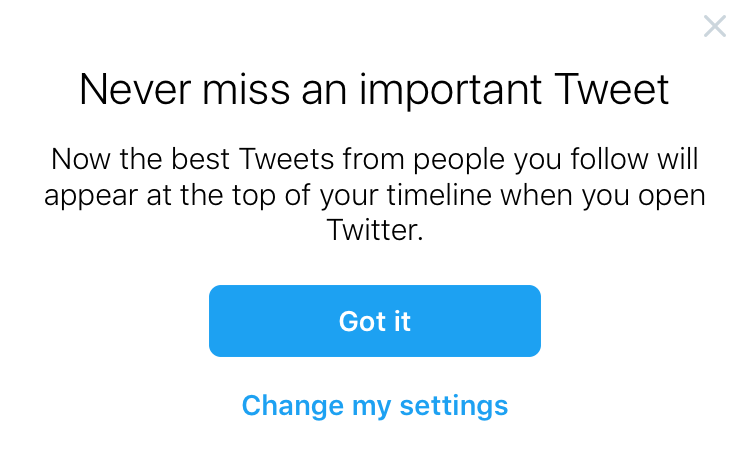
Twitter also updated their FAQ documentation to include this snippet:
Tweets you are likely to care about most will show up first in your timeline. We choose them based on accounts you interact with most, Tweets you engage with, and much more. You can find instructions for how to turn off this behavior here.
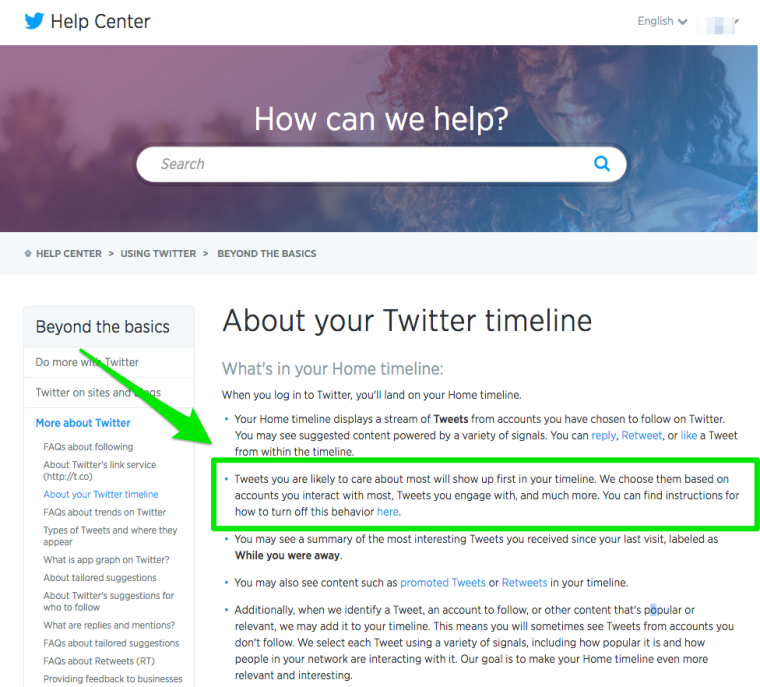
If you’re an #RIPTwitter supporter, you may want to adjust your settings in Twitter.
If you’re using Twitter on your desktop, login to your account. Then, click your profile in the upper right corner and choose Settings. Scroll under Content, uncheck “Show me the best Tweets first.”
Step 1:
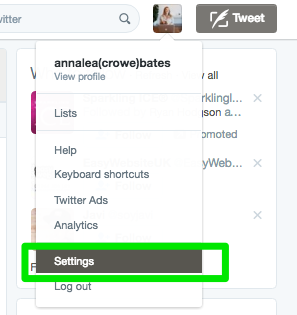
Step 2:
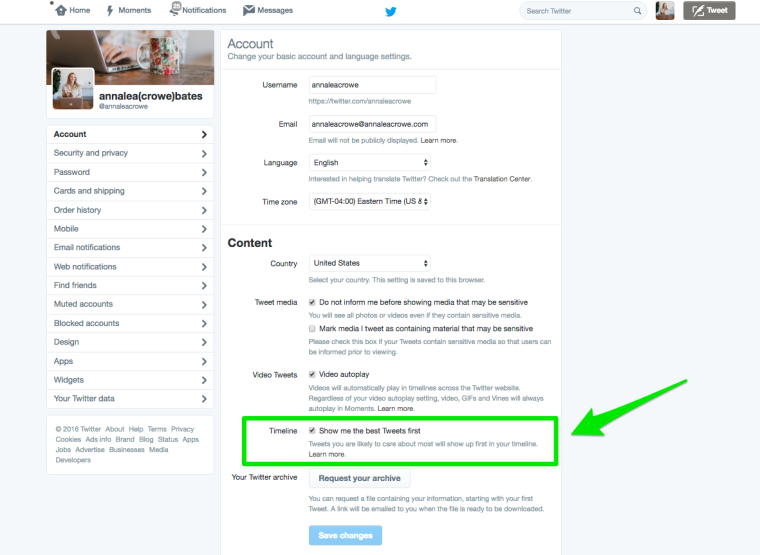
To adjust your settings in iOS, tap the gear icon to go to Settings. Next, head over to your account name then click Timeline Personalization under Timeline, and you’ll have the option to swipe “Show me the best Tweets first.”
As Twitter mentioned in their research, users who have used the new feature “tend to Retweet and Tweet more, creating more live commentary and conversations.”
#RIPTwitter, Really?
Twitter has already claimed its place among top social networks for businesses and users, thanks to its mobile users and embed tweets. What started as a text-to-friends birthed from Odeo is now projected to rack in $10 million in 2016 and will likely generate $2.6 billion in ad revenue.
The timeline update has however caused an uproar of complaints. It has gone as far as the custom #RIPTwitter hashtag that fans created asking Twitter to leave its timeline alone. Some have compared the changes to Facebook’s algorithm updates.
Take a look at some of the celebrity backlash:
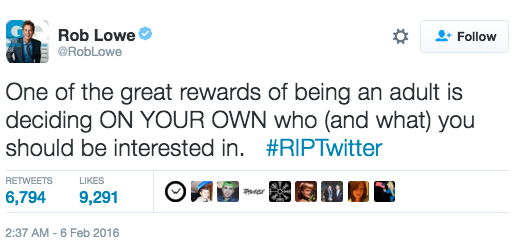
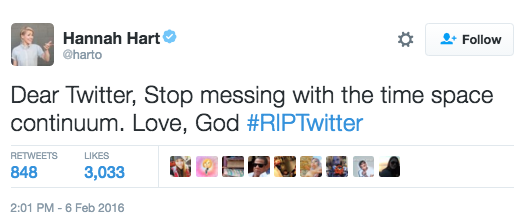
Okay, let’s all stop freaking out. This Twitter update is not a Facebook-inspired algorithm update like so many haters aim to think. This feed change was to give simply users what they want. People were feeling like they were missing all of the good tweets. Raise your hand if you missed this birthday shout-out? As the product manager, Michelle Haq said: “We wanted to change that feeling of missing out, which is why we decided to go after that problem.”
Now, let’s take a look at what digital marketers are saying:
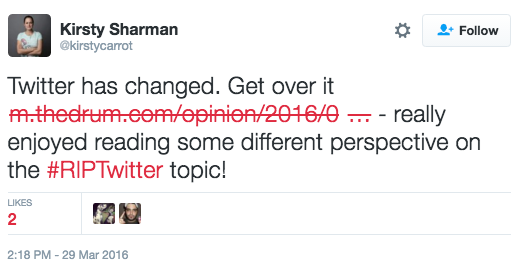
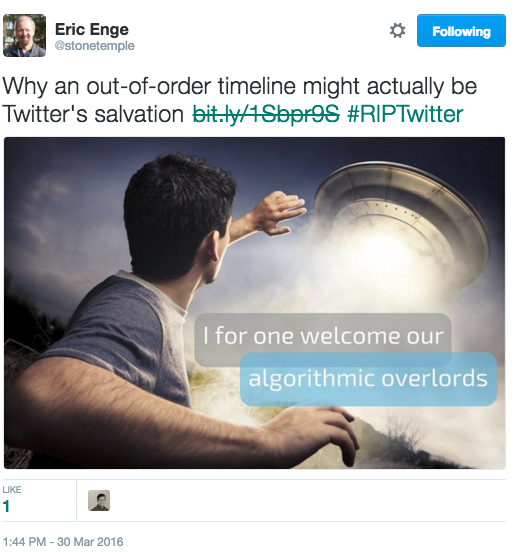
(If you still have an issue with the new Twitter Timeline, send a message to Twitter here.)
What are the Benefits of the Twitter Algorithm Change?
Tweets: I can’t live with ‘em and can’t live without ‘em. Since the new algorithm change (even though it’s a big update), I’ve tested out a few ideas (varying in brands from food, home decor, and technology) to know exactly what tactics you should be adding to your strategy this month. Consider these benefits of the new Twitter Timeline when mapping out your Twitter cheat sheet.
Tweets Have a Longer Time Span
Tweets are known for having a short half-life (2.8 hours to be exact). It doesn’t matter if you promote a single piece of content, or you’re really advanced to Cynthia Johnson-levels of doesn’t-matter-if-it’s-5am-let-me-tweet levels of obsession: No one likes to see their flawlessly curated tweet get zero retweets or <3’s. Before it was all about relevancy and tweeting 24/7 and, while this massive effort deserves a merit badge, the algorithm update has changed the game. Now, if you’re a tweeter who falls on the less is more side of the spectrum, you need to focus on scheduling your perfectly prepped content at an optimized time. This benefits smaller teams with less bandwidth.
Trending Topic Tweets Gain Larger Exposure
Ever since Twitter’s new algorithm launched, marketers can see new content related to popular tweets pop up in trending topics. While many of us have accepted some of these phrases as not only as much-discussed trends but also daily Twitter strategy choices. And it’s ones that most of us fully embrace — like SanDisk did below.
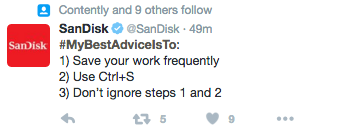
Tweets are Ranked by Engagement, Not by Frequency
If there’s one thing my SEO career has taught me over the years, it’s this: Whatever platform you’re working on, you will rank based on organic engagement and paid sponsorships. While the new Twitter algorithm change doesn’t have any known advantage for users who pay-to-play, your sponsored or promoted tweets may naturally show up in the Twitter timeline because there will be less noise from high-frequency tweeters.
[pullquote]
“This is a change that essentially makes all content on Twitter created equal. So this is a not pay-to-play platform, unlike our competitors’. The best content, whether it’s from a celebrity, another user or a brand, is always going to be what rises to the top.”
— Ameet Ranadive, Twitter’s VP of Revenue Product
[/pullquote]
The New Algorithm is Data-Driven
Twitter engagement rules may be fickle, but there’s one that will always remain true: Users see your tweet because Twitter believes they are genuinely interested in your content, and it is deemed relevant. But, content, like Tinder users, tends to be pretty hit-or-miss. To find the right partner (er, user) of your dreams that engages with your content, you’ve got to do some serious background work. Do you know what tweets are working best for you?
Before pushing content, consider what kind of content will benefit your users. Take a look into your Twitter analytics under Top Tweets to see what has been effective.
What Does this Mean for Brands?
So, let’s examine what this change in algorithm means for brands. To me, what makes a difference, and still will continue to do so, is getting ahead of the game with restructuring your strategies. What you have (to continue) to do as a marketer or brand is to produce quality content that drives engagement.
Here are tips to drive more engagement after the new Twitter Timeline update:
Host More Live Events
Twitter is starting to see users use the Live feature. People are tweeting more which turns into live commentary and active conversations. This can only benefit everyone as these functions continue to improve.
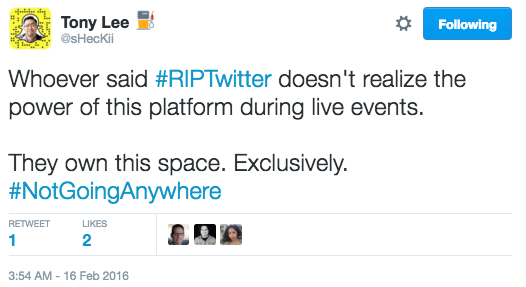
Start Paying the Big Buck$
Twitter is shifting to more meaningful and traditional ad-based measurements. We know people are reading Twitter for the content — and if you’re an advertiser, you can pay to target them. Twitter is becoming a mature advertising platform. It will be interesting to watch as they continue to grow.
Create Content that Cultivates Relationships
Brands need to connect their content to emotions. By doing this, brands can create tight bonds between the brand and the influencers. This new timeline feature could mean more meaningful interactions for brands. It’s just a matter of capturing those moments.
In honor of Twitter turning 10 in March, Twitter rounded up the 10 (good number, right?) most influential ways Twitter has changed marketing — both past and present. I’m talking the game-changing algorithm uproars (like the most recent), the risk-takers, the trend-starters, and those few ideas that embody everything about the 90s we want to forget.
Conclusion
Twitter is one of the biggest (and one my favorite) social media networks on the internet.
Twitter is not dead. It wasn’t dead in 2008. Simply put, user behavior is changing. The platform is changing. And, the marketing industry has to change with it.
Just like Facebook and Myspace, Twitter is answering the noise problem. The more content overload becomes a problem, the more we’re going to see social networks find a way to sort feeds.
With hundreds of millions of users, Twitter can be used to engage and link people in almost any target audience. The new Timeline update will see real results regarding traffic, shares, and conversions. The future of Twitter feels exciting. It seems like something big is coming. Twitter needed to do this to kickstart growth for 2016 and beyond. Let’s wait and see what they do with it!
Featured Image:Denys Prykhodov/Shutterstock.com
Screenshot by Anna Crowe. Taken March 2016.



